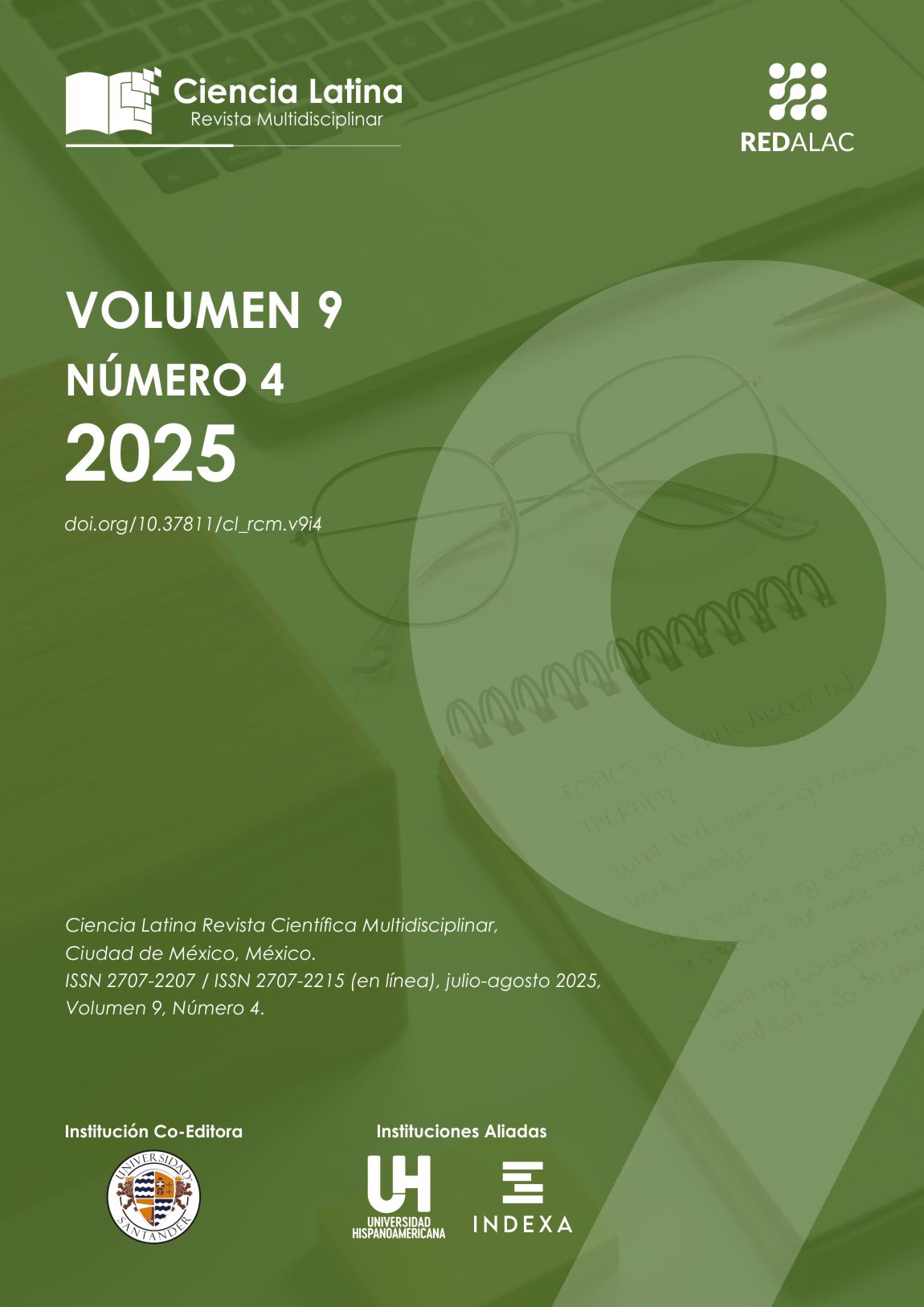Eritema multiforme: etiología y manifestaciones clínicas
Resumen
El eritema multiforme (EM) es una reacción cutánea aguda mediada inmunológicamente, se caracteriza por presentar lesiones típicas en diana o iris que afectan principalmente la piel y, en ocasiones, las mucosas. Su patogenia involucra una respuesta inmunitaria tipo hipersensibilidad que provoca daño en la epidermis mediado por linfocitos T citotóxicos, posiblemente desencadenada por agentes patógenos o fármacos. Entre las causas infecciosas más comunes se encuentran el virus herpes simple (VHS), siendo el principal desencadenante, y en la actualidad, el SARS-CoV-2 debido a que se ha reportado como un agente etiológico emergente asociado con casos de EM, probablemente debido a la activación inmune tras la infección o vacunación. Las manifestaciones cutáneas clásicas del EM incluyen máculas y pápulas eritematosas con distribución acral y simétrica que evolucionan a lesiones en diana con tres zonas concéntricas; estas lesiones muchas veces producen prurito o ardor. En casos severos, las mucosas también se ven afectadas, generando erosiones dolorosas. El reconocimiento del EM es importante para determinar cuál es el agente patógeno que lo produce debido a que la presentación clínica es variada, por ende, es importante manejar una terapéutica adecuada y evitar complicaciones.
Descargas
Citas
Hattori S, Miyagawa F, Fukuda K, Ogawa K, Asada H. Erythema multiforme major in angioimmunoblastic T-cell lymphoma. Acta Derm Venereol. 2021;101(12):165.
Bolognia JL, Schaffer JV, Cerroni L: Erythema multiforme, Stevens-Johnson syndrome and toxic epidermal necrolysis. Dermatology. Fourth Edition. Elsevier, China; 2018.
Kim JJ, Lee JK. Neonatal erythema multiforme associated with a rotavirus infection: a case report. World J Clin Cases. 2023;11(24):5749.
Rani Y, Hegde S, Patil B. Herpes associated erythema multiforme. World J Pharm Res. 2024;13(21):1277-82.
Noviello M, Lorentino F, Xue E, Racca S, Furnari G, Valtolina V, et al. Human herpesvirus 6–specific T-cell immunity in allogeneic hematopoietic stem cell transplant recipients. Blood Adv. 2023;7(18):5446-57.
Nicoli F, Clave E, Wanke K, von Braun A, Bondet V, Alanio C, et al. Primary immune responses are negatively impacted by persistent herpesvirus infections in older people: results from an observational study on healthy subjects and a vaccination trial on subjects aged more than 70 years old. EBioMedicine. 2022;76.
Fukunaga K, Tsukagoshi E, Kurata M, Mizukawa Y, Niihara H, Morita E, et al. Differential effects of HLA-B∗ 15: 11 and HLA-A∗ 31: 01 on carbamazepine-induced cutaneous adverse reactions. J Investig Dermatol. 2024;144(4):908-911.
Volkers SM, Meisel C, Terhorst-Molawi D, Burbach GJ, Schürmann D, Suttorp N, Sander LE. Clonal expansion of CD4+ CD8+ T cells in an adult patient with Mycoplasma pneumoniae-associated Erythema multiforme majus. Allergy Asthma Clin Immunol. 2021;17(1):17.
Daneshpooy S, Duffy RF, Joneja U, Heymann WR. Erythema multiforme with unique dyshidrosiform presentation. Int J Dermatol. 2023;62(1).
Damevska K, Vassileva S, Kostadinova-Kunovska S. Erythema Multiforme, Stevens–Johnson Syndrome, and Toxic Epidermal Necrolysis. In: Atlas of Dermatology, Dermatopathology and Venereology: Inflammatory Dermatoses. Cham: Springer International Publishing; 2021. p. 1089-1099.
Messina F, Fagotto L, Caroppo F, Salmaso R, Belloni Fortina A. Can erythema multiforme be an immune sequela of IgM nephropathy? A case report. Ital J Pediatr. 2022;48(1):181.
Morgado-Carrasco D, Mascaró JM Jr. Hallazgos de inmunofluorescencia indirecta en una paciente con lupus eritematoso cutáneo de tipo necrólisis epidérmica tóxica. Actas Dermosifilogr. 2022;113(9):905–6.
Yousefian M, Khadivi A. Occurrence of erythema multiforme following COVID-19 vaccination: a review. Clin Exp Vaccine Res. 2023;12(2):87.
Ricles V, Ahmed S, Trautz A, Braden MM, Erickson-Parsons L, Krakowski AC. Erythema multiforme in a child with Mycoplasma-associated infection. J Pediatr. 2023;257:113847.
Lança A, Bernardo M, Pinto S. Paediatric erythema multiforme: not every bullous rash is chickenpox. BMJ Case Rep. 2021;14(12):e246520.
Kim JJ, Lee JK. Neonatal erythema multiforme associated with a rotavirus infection: a case report. World J Clin Cases. 2023;11(24):5749–54.
Lazarević VV. Erythema multiforme: distinguishing hypersensitivity reactions, drug allergy, or herpes simplex infection. Explor Immunol. 2025;5:1003188.
Leung AK, Lam JM, Barankin B, Leong KF, Hon KL. Erythema infectiosum: a narrative review. Curr Pediatr Rev. 2024;20(4):462–71.
Zengin HB, Pukhalskaya T, Smoller BR. Role of CD123(+) plasmacytoid dendritic cells in etiologically different variants of erythema multiforme: a monocentric retrospective study. Dermatopathology. 2021;8(2):89–96.
Huyen TT, Phuong PTM, Lan PT, Vinh NTH. Serum concentrations of some T-helper1-derived cytokines in generalized erythema multiforme. Open Access Maced J Med Sci. 2023;11(B):665–70.
Zengin HB, Pukhalskaya T, Smoller BR. Role of CD123(+) plasmacytoid dendritic cells in etiologically different variants of erythema multiforme: a monocentric retrospective study. Dermatopathology. 2021;8(2):89–96.
Mawhirt S.L., Frankel D., Diaz A.M. Cutaneous manifestations in adult patients with COVID-19 and dermatologic conditions related to the COVID-19 pandemic in health care workers. Curr Allergy Asthma Rep. 2020;20(12):75. doi: 10.1007/s11882-020-00974-w.
Marzano A.V., Cassano N., Genovese G., Moltrasio C., Vena G.A. Cutaneous manifestations in patients with COVID-19: a preliminary review of an emerging issue. Br J Dermatol. 2020;183(3):431–442. doi: 10.1111/bjd.19264.
Català A., Galván-Casas C., Carretero-Hernández G., et al. Maculopapular eruptions associated to COVID-19: a subanalysis of the COVID-Piel study. Dermatol Ther. 2020;33(6) doi: 10.1111/dth.14170.
Bennardo L, Nisticò SP, Dastoli S, Provenzano E, Napolitano M, Silvestri M, et al. Erythema multiforme and COVID-19: what do we know? Medicina (Kaunas). 2021;57(8):828.
Kobyashi Y, Adachi T, Arakawa H, Takeuchi M, Inazumi T. Erythema multiforme following vaccination for SARS‐CoV‐2: report of a case and review of the literature – secondary publication. Australas J Dermatol. 2022;10–1111. doi:10.1111/ajd.13958.
Huynh T, Sanchez-Flores X, Yau J, Huang JT. Cutaneous manifestations of SARS-CoV-2 infection. Am J Clin Dermatol. 2022;23(3):277–86.
Mosina, P. C., Barabini, L., Crowe, C., Flores, R., Giacchetti, A., Larralde, M., ... & Scacchi, F. ACTUALIZACIÓN MANIFESTACIONES CUTÁNEAS DE COVID-19.
Bouabdella S, Benkaraache M, Almheirat Y, Zizi N, Dikhaye S. Erythema multiforme eruption due to SARS-CoV-2: case report. Ann Med Surg (Lond). 2021;68:102601. doi:10.1016/j.amsu.2021.102601.
Ambur AB, Mammino J, Nathoo R. Recurrent erythema multiforme induced by the combination of pembrolizumab and radiation. Cureus. 2021;13(11):e19202. doi:10.7759/cureus.19202
Silvi G, Rosi E, Scandagli I, Di Cesare A, Prignano F. Erythema multiforme as a rare skin manifestation during pembrolizumab treatment: a case report and literature review. J Chemother. 2025;:1–5.
Kim JC, Kang SY, Chung BY, Park CW, Kim HO. Case report: erythema multiforme induced by lithium contact. Ann Dermatol. 2023;35(Suppl 2):S225.
Solano N, Gutierrez P, Parra E, Gutierrez V, Ramos S. Eritema multiforme como manifestación paraneoplásica de un adenocarcinoma de colon. Int J Interdiscip Dent. 2022;15(1):84-6.
Costantini, M. S., Loriente, D. M., Alfaro, C. T., & Della Giovanna, P. S. (2024). Síndrome multiorgánico autoinmune paraneoplásico desencadenado por radioterapia. Dermatología Argentina, 30(2), 95-98.
Villegas-Blanco YA, Sáenz AM, Ball E. Síndromes paraneoplásicos: la importancia de la dermatología clínica. Dermatol Venez. 2023;61(1).
Ferro AA, Palacio C, Mazzotta MM, Zalazar EV, Cabalier ME. Consideración del espectro de eritema multiforme en la era de la polimedicación. Rev Fac Cien Med Univ Nac Cordoba. 2022;79(Supl JIC XXIII).
Pereira, R. L., Pereira, M. O., Ferreira, C., & Neves, I. (2024, November). Eritema multiforme mayor/síndrome de Stevens-Johnson: un desafío diagnóstico. In Anales de pediatría (Vol. 101, No. 5, pp. 361-363). Elsevier Doyma.
Falconí Chávez DS. Síndrome de Steven-Johnson y necrólisis epidérmica tóxica: revisión bibliográfica actualizada. 2023.
Gungor T, Gumru S, Gumru B. Erythema multiforme: a retrospective study of etiologies, clinical manifestations, and treatments. J Dent Sci. 2024;19(4):2295–2304.
Fan X, Luo Y, Lu J, Xu J, Chen Q, Guo H, Jin P. Erythema multiforme major associated with community-acquired pneumonia: lessons from a case report. Front Pediatr. 2021;9:698261.
Zhu Q, Wang D, Peng D, Xuan X, Zhang G. Erythema multiforme caused by varicella-zoster virus: a case report. SAGE Open Med Case Rep. 2022;10:2050313X221127657. doi:10.1177/2050313X221127657.
Senger B, Memar SA, Ahmann A, Houser JJ, Doughty-McDonald L, Ahmann A. Dermatologic and ophthalmologic treatment of erythema multiforme major: a case report. Cureus. 2021;13(12):e20414. doi:10.7759/cureus.20414.
Aydın SA, Metbulut AP, Mısırlıoğlu ED, Metin A. Use of valacyclovir prophylaxis in herpes virus-associated recurrent erythema multiforme cases. Turk Cocuk Hast Derg. 2023;17(2):166–70.
Cantero, M. F., Emma, Y., Giangualano, E., García, S., & Aloise, Í. (2022). Eritema multiforme mayor asociado a infección por virus herpes simple. Dermatología Argentina, 28(2), 89-91.
Derechos de autor 2025 Ana Cristina Oscuez Mayorga , Karen Lissbeth Espinosa Feijoó , Jonathan Guillermo Villacís Castro, Carla Doménica Montalvo Izurieta

Esta obra está bajo licencia internacional Creative Commons Reconocimiento 4.0.











.png)




















.png)
1.png)


